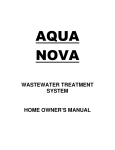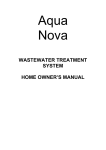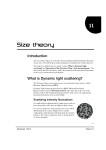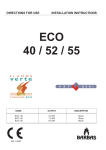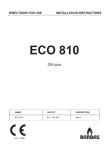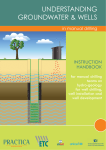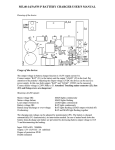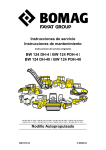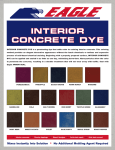Download OPERATIONAL PROCEDURES for CEMENT
Transcript
OPERATIONAL PROCEDURES for CEMENT & RENOLITH ® POLYMER STABILISED ROAD PAVEMENT CHAPTER I General Article 1. Domain of Application: This book is for the execution and delivery of cement and Renolith chemical additive to construct polymer stabilised road pavements. It contains the technical details and materials needed for execution. 1.1 Cement stabilised pavements for roads, airfields, rail embankments and hardstand storage areas has now been generally accepted world-wide. While various cement materials have been used, such as hydrated lime and fly ash, Portland has been generally accepted by governmental and private contracting agencies as being the preferred active binder for soil stabilisation, due to its ability to flocculate the very fine particles of silty soils and highly plastic soils. 1.2 The use of polymer-creating additives that further enhance the tensile strength, flexibility and resistance to moisture permeation in stabilised pavement has been growing steadily across the world. Not only are these technical benefits accruing from the use of these chemical additives with cement, but also the substantial economic and environmental cost savings that go with the predominant elimination of imported quarried hard rock aggregates, and the much reduced environmental cost thereof, especially in the European Union, where vastly greater emphasis has been placed on environmental issues and their resolution. 1.3 The most immediate effect of the use of cement-polymer pavement stabilisation, is the virtual elimination of the need for various graded aggregates in road pavement construction. Article 2. 2.1 Objective To improve both the workability of the cement stabilisation process for road construction; to reduce the likelihood of any cement stabilised pavement failure due to shrinkage of the cement on setting; and to give greater tensile strength and flexibility to the pavement. 2.2 Article 3. (i) The standard international road flexible cement stabilised pavement design as undertaken shall be retained, as if the additive product has not been included, and shall depend on the road usage, respective axle loadings, terrain, soil type (especially regarding high plasticity soils) and whether the road is to be sealed or unsealed; and (ii) Road lateral and longitudinal subsoil drainage and table drains shall be provided to protect the earthworks and pavement material, including the mix so formed by the inclusion of the Renolith additive product into the pavement material mix. Defining Types of In-Situ material 3.1 Renolith polymer-creating additive is designed to work in conjunction with cement with a wide range of soil and sub-grade types to make a strong and flexible pavement for roads and to enhance quality and durability of the final pavement 3.2 The volume of cement and the diluted application rate of Renolith are determined by various factors that must first be established to enable proper design of the road. These factors include the plasticity of the road sub-base, the type of sub-base soil, the CBR (Californian Bearing Ratio), projected traffic including maximum axle load weight, volume of projected traffic and the required lifetime of the road pavement. 3.3 The volume of cement appropriate to the different soil types and plasticity index is shown in the guide line in the following Table 1. Note: These are typical indicated values only, which must be verified or amended by the manufacturer or consulting engineer. Table 1 Soil Types & Cement Required for Stabilization Plasticity Index ( from Atterberg Limits ) PI Typical Soil, Sub-base, or Subgrade Description > 24 Highly Plastic / expansive CLAYS , often black 6.0 – 7.0 Highly Plastic / expansive CLAYS , often black or red, brown, grey mottled 5.0 – 6.0 20 - 24 Nominal Cement Ranges ( % ) 3.4 16 - 20 Moderately Plastic / expansive CLAYS and SILTY CLAYS Often black/grey, red, brown or grey mottled 4.0 -5.0 10 - 16 Moderately Plastic CLAYS, SILTY CLAYS and SANDY CLAYS, often red or brown / grey mottled 3.0 – 5.0 6 - 10 Low Plasticity CLAYEY SILTS and CLAYEY SANDS Often red, brown or grey mottled – often friable 3.0 – 4.0 <6 Low Plasticity CLAYEY SANDS often red, brown, grey White – often friable 3.0 River SANDS or SILTY SANDS, fine and rounded, Uniform grading, white or grey 3.0 Beach or River SANDS, course and angular, white, Orange or grey 2.0 – 3.0 The application rate of Renolith appropriate to the soil type and plasticity index is indicated in Table 2. Table 2 - Material Estimates - Renolith Additives for Road Construction Pavement Cement Content Renolith/Water 2% 3% 4% 5% 6% 7% 120 Cement (kg/m2) Renolith (l/m2) Water (litres) 4.8 0.12 1.2 7.2 0.18 1.8 9.6 0.24 2.4 12.0 0.30 3.0 14.4 0.36 3.6 16.8 0.42 4.2 150 Cement (kg/m2) Renolith (l/m2) Water (litres) 6.0 0.15 1.5 9.0 0.23 2.3 12.0 0.30 3.0 15.0 0.38 3.8 18.0 0.45 4.5 21.0 0.53 5.3 180 Cement (kg/m2) Renolith (l/m2) Water (litres) 7.2 0.18 1.8 10.8 0.27 14.4 0.36 2.7 3.6 18.0 0.45 4.5 21.6 0.54 5.4 25.2 0.63 6.3 Depth (mm) CHAPTER II 200 Cement (kg/m2) Renolith (l/m2) Water (litres) 8.0 0.20 2.0 12.0 0.30 3.0 16.0 0.40 4.0 20.0 0.50 5.0 24.0 0.60 6.0 28.0 0.70 7.0 225 Cement (kg/m2) Renolith (l/m2) Water (litres) 9.0 0.23 2.3 13.5 0.34 3.4 18.0 0.45 4.5 22.5 0.56 5.6 27.0 0.68 6.8 31.5 0.79 7.9 250 Cement (kg/m2) Renolith (l/m2) Water (litres) 10.0 0.25 2.5 15.0 0.38 3.8 20.0 0.50 5.0 25.0 0.63 6.3 30.0 0.75 7.5 35.0 0.88 8.8 275 Cement (kg/m2) Renolith (l/m2) Water (litres) 11.0 0.28 2.8 16.5 0.42 4.2 22.0 0.55 5.5 27.5 0.69 6.9 33.0 0.83 8.3 38.5 0.97 9.7 300 Cement (kg/m2) Renolith (l/m2) Water (litres) 12.0 0.30 3.0 18.0 0.45 4.5 24.0 0.60 6.0 30.0 0.75 7.5 36.0 0.90 9.0 42.0 1.05 10.5 350 Cement (kg/m2) Renolith (l/m2) Water (litres) 14.0 0.35 3.5 21.0 0.52 5.2 28.0 0.70 7.0 35.0 0.87 8.7 42.0 1.05 10.5 49.0 1.22 12.2 3.5 The cement and Renolith application rates shown in Tables 1 & 2 are indicative only, and in each case the Renolith distributor should be consulted for the recommended application rates appropriate to the particular road design and the factors outlined in 2.2 3.6 Renolith and cement can be successfully used for the rehabilitation of existing road surfaces where the asphalt topping layer has suffered deterioration through time, weather and use beyond the design capability of the wearing surface. See Article 17. Nature, Quality and Preparation of Materials Article 4. Aggregates 4.1 The construction of cement stabilised road pavements has been accepted and used world-wide for many years as this technology enables considerable savings in material costs, environmental costs and time. Cement has the effect of flocculating the fine grains of silty soils and plastic clays, allowing better compaction and reducing the capillary effect of moisture intrusion, which causes clays to expand. 4.2 Cement stabilised road pavement eliminates the need to bring in expensive crushed aggregates to form road sub-base, because the chemical reaction of Renolith, cement and water with soil creates a bound material with greater tensile strength and resistance to moisture penetration than conventional road base and sub-base layers comprised of graduated aggregates. 4.3 The use of Renolith additives to cement, water and in-situ soil material has increasingly gained favour since it was first developed and used in Germany more than 20 years ago. It enhances the tensile strength and flexibility of the cement-stabilised pavement layer, providing greater resilience to surface deflection caused by traffic, and even greater resistance to moisture penetration, because the voids between material particles are eliminated, giving even greater resistance to moisture penetration. Apart from the greater residual strength of the pavement, the effect of freeze-thaw heave is substantially reduced and in many cases eliminated. 4.4 Accordingly, it is not necessary to specify grades of aggregate to be used in a cement-Renolith stabilised road pavement, as the import to site of expensive aggregates is largely avoided. Article 5. 5.1 Active Binder Standard Portland GP cement is used as the active binder. Quick setting cement should not be used. Article 6. Renolith Additives 6.1 Renolith used as an additive to cement and in situ soil material comprises hydrated calcium chloride and acrylic copolymer latex in a solution of water, and should comply with ISO 9001:2008 Article 7. Tacking Coat 7.1 Where the finished cement-polymer stabilised pavement is to be topped with either Hot Asphalt Mix (HAM) or chip seal to provide a wearing surface, the stabilised pavement should be coated with an appropriate liquid bitumen emulsion. (e.g. Colas R175 or R250) to provide a tacking coat for the bitumen. 7.2 A first coat of bitumen emulsion is applied by hand-held wand sprayer attached by hose to the discharge pump on the bitumen tanker, or by direct spray from the bitumen tanker. Care must be taken to ensure that the entire pavement area is liberally coated and allowed to dry. Drying time will vary depending on air temperature, but the water content of the emulsion evaporates leaving a coating of charged particles of bitumen which turns black when total water content evaporation has occurred. 7.3 The second coat of bitumen emulsion can be applied immediately after the first coat has evaporated and become touch dry. 7.4 If a hot mix asphalt wearing coat is to be used, application can be undertaken at any time after the second tack coat has dried, and standard spreading and roller compaction procedures followed. 7.5 If a wearing coat of 10mm hard aggregate is to be used, spreading by truck can commence immediately after the second tack coat is applied. This is undertaken by a tipping truck following immediately behind the bitumen emulsion spray and either mechanically or hand spreading of the aggregate to ensure complete coverage of the tack-coated stabilised pavement surface. 7.6 Where a heavier wearing layer is required by the design specifications, the loose surface aggregate should be removed by brushing, and a third coat of bitumen emulsion applied, followed by a second layer of 10mm hard aggregate applied. Article 8. High Plasticity In Situ Soil Material 8.1 Where highly plastic clays are encountered in the sub-base layer, a stratum of low plasticity material should be added to a depth of 100mm over the clay. This can consist of laterite, crushed limestone, sand or fly ash. Article 9. Fibres 9.1 Where the in situ soil material consists of highly plastic clays the design specification may require the laying of a geotextile prior to stabilisation of the pavement layer to provide a wick for added lateral drainage. Article 10. Water 10.1 Water used for admixture with cement, Renolith and in situ soil material may be pure water, brackish water or seawater, provided that it is clean and contains no organic material contamination. Article 11. Quality Control Before Use. 11.1 Portland GP cement used in the pavement stabilisation process should not exceed three months age from date of manufacture to delivery to site, and should be covered to protect from humidity caused damage. 11.2 Renolith additive should be in sealed drum containers as delivered from the manufacturer and must be protected from dilution by water or other contaminants prior to use. CHAPTER III Method of Mixture Article 12. Composition of Mixture 12.1 Portland GP cement, Renolith additive and water in the proportions required for the specifications as per tables 1 and 2 or as specified by the manufacturer or consultant, are mixed on site with the aggregate, natural stone, and soil fines in situ. Article 13. Physical Mechanical Characteristics of Mixture 13.1 When Renolith is mixed with the in-situ material and cement, an exothermic reaction occurs between the cement and Renolith which changes certain characteristics of the cement to create a high tensile strength mixture, which binds the aggregates and fines in situ, eliminating voids between the aggregate components and fines. 13.2 The mixture remains in a workable condition for a period of time to enable compaction, trimming and rolling to provide a finished pavement surface of the specified depth. Optimum performance is gained by compaction immediately after completion of the stabilisation mixture. Article 14. 14.1 Equipment Equipment required (all in good working condition) typically will include: (i) Road Grader (Cat 12 equivalent or larger) with Rippers and Tines; (ii) Stabilisation Machine (pass width generally 2.0 to 2.7 metres); (iii) Bulk cement spreading truck(s) or flattop truck(s) for bagged cement; (iv) Water Trucks (2 minimum) (v) Water Truck with horizontal rear mounted spray-bar with all fully operational flow rated nozzles; (vi) Article 15. Rollers:- sheep-foot or equivalent with tractor for pulling or self-propelled - steel drum, self-propelled (preferably 10-15 tonne) - Multi pneumatic tire self-propelled (vii) Farm tractor with power take-off and heavy duty rotary hoe. (e.g. Bomag) (viii) Road broom or equivalent. Making the Mixture of Renolith Additive and Water 15.1 When mixing, the concentrated Renolith liquid should always be added to the water. 15.2 The tanker truck/water cart should be filled with water, leaving sufficient capacity for the Renolith to be added. 15.3 The volume of Renolith required by the specifications (e.g. 3 litres concentrate to 10 litres water) should then be pumped from the delivery container to the tanker truck/water cart. 15.4 The pump delivery hose should be introduced into the top tanker truck delivery port before starting the pump. 15.5 Moving the end of the delivery hose within the tank will assist agitation with thorough mixing of the solution. 15.6 Care should be taken to ensure that the correct volume of Renolith is mixed with water in the tank. Article 16. Regulating the Site for Mixing Renolith and Water 16.1 No special mixing site need be provided. This procedure can be done at any convenient place on or adjacent to the stabilisation area where the tanker truck/water cart can be positioned conveniently beside the bulk polymer supply. Article 17. Control of Mixing in the Stabilisation Process 17.1 Thorough mixing of cement, Renolith and the in-situ material is critical to the success of the stabilisation process. 17.2 The Stabilisation Procedure as set out in Article 26, should be carefully followed to ensure the complete mixture within the stabilised pavement for optimum performance. CHAPTER IV Method of Operation Article 18. Transport and Handling of Renolith 18.1 Renolith is supplied in concentrated form in 200 litre drums on pallets, or 1000 litre pallecons, which may be safely transported on conventional trucks. 18.2 Renolith is not flammable, toxic or hazardous, and does not require special handling conditions. 18.3 Renolith is not environmentally hazardous, and spillage can be readily dealt with by hosing with water to clean the ground surface where spillage has occurred. 18.4 Standard Health and Safety conditions should be observed, and use of protective gloves and goggles is recommended for personnel unloading Renolith and decanting the concentrated liquid to the tanker trucks for dilution and mixture according to the specifications. Article 19. Transport and Handling of Cement 19.1 Cement delivered to site by bulk tanker should be transferred by pumping to the cement spreading truck prior to commencement of work. 19.2 Cement delivered to site in bags must be covered to prevent air contamination from any broken bags or loose cement during windy conditions, and to avoid damage by humidity or a rain event prior to spreading. 19.3 It is recommended that personnel handling cement during hand spreading should wear protective gloves and aspirator face masks. Article 20. Preparation of Work 20.1 Check area with Stabilizer (if required). One pass of the stabilizer can be run without cement or polymer over a short length of road surface (say 50 metres) to determine how the stabilizer handles the in-situ material. If the material is too compacted, tinning the area with the grader may be required. This will reduce the work required by the stabilizer and assist in loosening the material prior to the stabilization process. Article 21. Laying of Cement 21.1 The cement spreading truck should commence the procedure by laying cement across the full width of the pavement to be stabilised. Cement is applied directly to the ground comprising the proposed road or road to be rehabilitated. 21.2 If cement is delivered to site in bags, bags should be dumped directly from the delivery truck on to the road surface at the spacing prescribed in the specifications and spread with a spreader bar or by hand using rakes to achieve the specified application rate per square metre. 21.3 Application of cement to the paving area should be immediately followed by commencement of the stabilisation process. Article 22. Compaction 22.1 Initial compaction should immediately follow completion of the stabilisation and mixing process. 22.2 Initial compaction is undertaken by not less than two passes of a 10 tonne pad foot roller or four passes of a 5 tonne roller. 22.3 Initial compaction is followed by trimming to finish level and fall by grader. 22.4 Secondary compaction is then undertaken by non-vibrating flat drum roller – minimum of two passes by a ten tonne roller or four passes by a five tonne roller. 22.5 Final compaction is then performed by multi pneumatic tyre roller in a minimum of two passes. 22.6 (i) As with most polymer forming compounds, a low level of heat is generated in the chemical reaction’s occurrence and accordingly, limited time is available to complete the mixing after the product has been incorporated. Hence, the length of the section under construction should be limited to the time available, the mixing, rolling and trimming equipment availability and expertise available for the operation of such equipment; (ii) Additional water may be required during mixing, to maintain OMC and accordingly a stand-by water truck loaded with water only should be available; (iii) Spray-bars used for depositing the Renolith diluted liquid into the pavement material mix shall have their nozzles directly pointing into the construction area and not be able to spray outside this area (i.e. not to waste product); (iv) Depending on the capacity of the stabiliser being used, and if pavement depths greater than 250mm are required, stabilisation may be undertaken in layers of a maximum depth of 250mm each. Article 23. Surface Treatment of Finished Layer 23.1 If the road pavement surface is not required to be finished with a bitumen wearing layer, it should be treated with an aggregate pressed into the surface in accordance with Article 26.3, I, ii and iii. 23.2 If the road pavement surface is required to be finished with a bitumen wearing layer, it should be treated as provided in Article 7. Article 24. Control of Operating Method 24.1 The General Foreman is responsible to ensure that all of the required resources and personnel are available prior to commencing any road stabilization activities. The General Foreman is also responsible to determine the areas to be completed and to provide detail of cement and Renolith quantities required and the rates of application to the Senior Foreman in charge of the crew. The General Foreman is responsible to communicate any problems or issues to the Manager/Consulting Engineer for resolution. 24.2 The Senior Foreman is responsible for the coordination of equipment and personnel to undertake the stabilization works. The Senior Foreman is responsible to ensure that the instructions from the General Foreman are followed by the crew. The Senior Foreman is responsible to communicate any problems or issues to the General Foreman for resolution. 24.3 The Senior Foreman is responsible to supervise the crew in the completion of the works and to ensure that the work is completed following all safety requirements and in line with the instructions given. The Foreman is responsible to communicate any problems or issues to the Senior Foreman for resolution. Article 25. Flow Chart of Operations Stage 1: Preparation Stage 2: Stabilization Stage 3: Completion Ensure road profile is to design. Correct areas needing attention. Fill Water Cart #1 with Water and Renolith Water Cart to give light watering How is Water Content? Wet area with watercart if necessary. Cement Spreading Compact with Smooth Drum Roller Stabilization with Watercart / Tractor / Stabilizer Final Trim with grader How is the compactionof the material - too tight for stabilizer? Tyne the area with the grader if required. Compaction with Sheepfoot Roller Initial Trim with grader to reshape and remove excess material Notes: Water Cart to give light watering Final finish roll with Smooth Drum Roller Prior to Wearing Coat Layer Spread 75mm Neutral material as the wear course Two Tack Coats of Bitumen Emulsion before Wearing Coat Layer Compact with Smooth Drum Roller to embed 75mm material 75% into pavement Spread 10-15mm crushed stone wearing layer Or Hot Mix Asphalt 1. a) b) c) Assess the previous day’s work to fine tune the crew work procedure. Assess effectiveness of traffic control, traffic movement, etc. during the stabilization process. Discuss job with crew to identify and address any problems they may have. a) Pavement Finish for heavy duty mine and forestry roads: Application of a wearing coat layer of 75mm ᴓ crushed hard stone, embedded 75% into pavement surface. Pavement Finish for light to medium traffic public and private roads: Application of two coats of Bitumen Emulsion and 10-15 mmᴓ crushed hard stone; or One coat of Bitumen Emulsion tacking coat followed by application of Hot Mix Asphalt (HMA) 2. b) c) Article 26. Procedures 26.1 Preparation i. Use Grader to profile surface of road to be stabilized (if required). In areas where the road has lost shape through erosion, the road surface needs to be shaped to the desired final profile prior to any stabilization works commencing. This work should be done well in advance of the stabilization works. If necessary, tine the area to be stabilised with the grader to break up the surface layer and facilitate more efficient performance of the stabiliser. ii. Water the area (if required). The work area material will be checked for Optimum Moisture Content (day prior to stabilization or on the morning of starting in that area) and if required the water cart will spray the area with water to raise the moisture content of the material to assist in achieving the Optimum Moisture Content (OMC) of 5% for later compaction. iii. In cases of Low Moisture Content (if required), the water cart should pass over the area of low moisture, with water only, thereby cutting the material and introducing additional moisture. This will raise the moisture content to get it closer to Optimum Moisture Content (OMC) of 5% in preparation for stabilization and compaction. iv. 26.2 Where the design specifications for a road require the finished level of the new pavement to be reduced in height, the top layer of in-situ material should be excavated and removed to stockpile for re-use. The depth of this material removal should equate to the specified depth of stabilised pavement determined in accordance with the specifications and the factors mentioned in Article 3. The excess sub-base material should then be excavated to a depth equivalent to the required height reduction in the finished pavement level, and removed. After removal of the excess material, the top layer material previously removed to stockpile should then be replaced in-situ and compacted with a sheep-foot roller as specified in Article 22.2 before commencement of stabilisation. Stabilization i. Spread the cement (either by mechanical spreader or manually over the area to be stabilized at the required dosage as provided in Article 21. (e.g. 20kg /m2). At this application rate and with each bag weighing 20kg - there needs to be a bag placed at each square metre of road surface. Use a spreader frame to position the bags of cement accurately (see diagram below). After placement, cutting and emptying the bags, a spreader can be dragged to spread the cement evenly, or alternatively hand spread by rake. ii. If a cement spreading truck is available the spreading rate must be calibrated to allow the correct volume per metre of cement to be spread evenly on the road area to be stabilised. The cement spreader then passes over the area to be stabilised, ensuring that the cement is spread evenly over the area to be stabilised. iii.. The water-cart with Renolith and water and Tractor / Stabilizer are then engaged in train to undertake the stabilisation pass to the full depth according to the design specifications in each case, while adding the polymer solution. The water-cart is to be filled with the Renolith / water mix for this step. The Tractor/stabiliser is to be connected behind the water-cart by means of a draw-bar to ensure that the equipment operates as a single unit, at a set separation distance. The hoses from the water cart are connected to the delivery pump on the tractor/stabiliser to deliver the correct polymer / water solution via the stabilizer. This solution will be metered via the pump and delivered at the rate per m2 according to the design specifications. This is closely followed by the sheep-foot roller to achieve 103% compaction. The Tractor / Stabilizer, material hardness and the rate of cement spreading will determine the speed of progress during this step. For this reason, the water cart is pushed by the Tractor / Stabilizer. iv. With the water cart disconnected, the tractor/stabiliser makes a second pass over the stabilised area to ensure thorough mixing of the cement, Renolith and in-situ material. Alternatively a second stabiliser or tractor-mounted heavy duty rotary hoe/mixer can be used to carry out this second pass. v. It is recommended that a second stabiliser or rotary hoe be engaged to make this second stabilisation pass to ensure complete mixing of the pavement material. **That will free the tractor/stabiliser/water cart train is free to continue forward stabilisation. vii The Sheep-foot roller is the engaged immediately after the second stabilisation pass in accordance with Article 22, followed by grader trim and flat drum roller compaction and pneumatic tire roller. Compaction is to commence within thirty (30) minutes after completion of water addition to the pavement. viii. 26.2 Compaction achieved, as determined by tests of the in-situ material shall be not less than 98% standard of the maximum dry density. Application Rates Application rates for cement and Renolith shall be determined on site for the equipment available from application rate tables provided with product or as specified by the manufacturer or Consulting Engineer. Physical application rates will be determined for speed of application of the cement or Renolith, outlet rates or spray nozzle ratings and for pavement/earthworks depths under construction. This will be determined as a part of the stabilisation activity by the Consulting Engineer or on site by the Senior Foreman following appropriate training. 26.3 Completion i. Initial grade The grader completes the initial grade to bring the road back to the design levels and designed road shape as the polymer increases the volume of the mix. Only use experienced grader operators. Any excess material may need to be loaded out for use in other areas. ii. Surface gravel course: If a gravel wearing course is required by the specifications, a tipping dump truck with a tail gate can be used to add a top course of neutral 10mm gravel prior to final compaction. This top course will provide a wearing surface to the stabilized pavement. See Note 2 to Article 25. Some final trim grading may be required also. iii. Final compaction using a non-vibrating smooth drum roller used to push the wearing course into the pavement material. iv. Equipment Train in Operation Grader tines Road surface Step 1. Water to obtain OMC Step 2. Cement Spreading Step 3. Stabiliser linked to Polymer/water tanker Step 4. 8. CHAPTER V Technical Quality Conditions of the Completed Stabilised Layer Article 27. Finished Layer Characteristics Sheepfoot Roller compact Step 5. Grader Trim Step 6. Flat Drum Roller Step 7. Multi Pneumatic Tire Roller Step 27.1 Curing of the cement/Renolith polymer stabilised pavement begins when the materials are mixed by the stabiliser, which creates an exothermic reaction. Curing will continue over the following 28 hours by which time the pavement will have achieved full curing. 27.2 The finally rolled, smooth finished pavement will have cured sufficiently after two hours, to allow monitored, slow traffic to access the pavement. Article 28. Geometrical Elements and Tolerances Stabilised pavements must be completed with a maximum tolerance of -/+ 10% CHAPTER VI Delivery of Works Article 29. Reception of Determined Phases Article 30. Preliminary Reception Article 31. Final Reception APPENDICES I Use of Bitumen Emulsion on Finished Cement-Polymer Pavement II Schellenberg Test III Normative References























